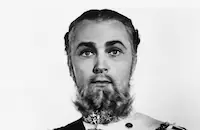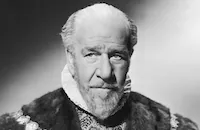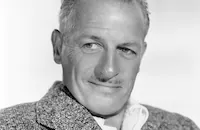The Locket

Brief Synopsis
Cast & Crew
John Brahm
Laraine Day
Brian Aherne
Robert Mitchum
Gene Raymond
Sharyn Moffett
Film Details
Technical Specs

Synopsis
Shortly before he is to wed, millionaire John Willis is visited by Dr. Harry S. Blair, a psychiatrist who informs him that years before he was married to Nancy, John's wife-to-be, and warns him that she is mentally unbalanced. Blair then relates the following story: After a whirlwind romance in Florida, Blair marries Nancy and starts a psychiatric practice in New York. One day, artist Norman Clyde comes to his office and tells him that an innocent man is about to be executed in Sing Sing Prison and that Nancy is the cause of his unjust incarceration. A distraught Clyde then explains himself to a curious Blair: Three years before, Clyde meets Nancy, whose maiden name was Monks, when she enrolls in his art class. The moody Clyde soon falls in love with Nancy's honest charm and beauty. Nancy, a secretary, introduces Clyde to her boss, millionaire Andrew Bonner, and persuades Bonner to showcase Clyde's paintings at one of his private showings. To Nancy's delight, Clyde's painting, a depiction of the tragic figure Cassandra for which she modeled, wins first prize at the showing. The evening is perfect until an expensive bracelet is stolen from a guest, and Clyde later finds it in Nancy's purse. After Clyde confronts a confused Nancy about the theft, she relates the following story to explain her behavior: As a young girl, Nancy lives with her housekeeper mother in the lavish Willis home and plays with Karen, the Willises' little daughter. Although Karen wants to invite Nancy to her upcoming birthday party, Mrs. Willis refuses to allow the lower-class Nancy to attend. A true friend, Karen promises to give Nancy one of the pins her guests are receiving. When Karen realizes there are no extra pins, however, she offers Nancy the beautiful locket she has just received from her mother. Nancy's subsequent joy is soon crushed when Mrs. Willis demands that she return the locket. Later, the locket is discovered missing, and Nancy is accused of theft. Although Nancy's mother soon finds the locket in Karen's dress, Mrs. Willis refuses to believe Nancy and forces her to "confess." The adult Nancy then admits to Clyde that this childhood humiliation caused her unconscious desire to steal the bracelet at the party. After a forgiving Clyde returns the bracelet anonymously, he and Nancy continue their romance until the next party at the Bonners'. Suspecting that the absent Nancy is spending the evening in Bonner's arms, Clyde leaves the party to look for her and sees her exiting Mrs. Bonner's bedroom just after two gunshots are fired. Bonner is found murdered, and Mrs. Bonner's diamond necklace, stolen. Although Nancy and Clyde are questioned, valet Myron Dexter is eventually found guilty and is sentenced to die. Clyde, however, strongly suspects Nancy, but she angrily maintains her innocence and leaves for Florida. Back in his office, Blair defends Nancy to Clyde but invites him to his house that evening. When confronted, Nancy denies everything and tells Blair that Clyde is merely jealous. The next day, Dexter is executed, and a guilt-ridden Clyde jumps from Blair's office window to his death. To avoid scandal, Blair and Nancy move to England, and after World War II breaks out, Blair volunteers his medical services, while Nancy becomes an ambulance driver. Expressing concern over Blair's health, Nancy insists that they take a vacation at Lord and Lady Wyndham's manor house. Just as they are leaving, Blair learns that one of Lady Wyndham's valuable jewels has been stolen. Blair suspects Nancy but is unable to prove anything until a bomb destroys their flat and reveals her cache of stolen jewels. Although confronted directly, Nancy continues to deny any guilt and divorces Blair after he suffers a nervous breakdown. Back in John's study, Blair, like Clyde before him, tries to convince John to abandon Nancy, who now uses the name Patton. John, however, believes Nancy when she tells him that Blair is still suffering from his breakdown. Moments before the wedding is to start, Nancy's future mother-in-law, the unsuspecting Mrs. Willis, gives her the same locket that she once took away, and tells her that it is a precious family heirloom. The locket causes Nancy to be overcome with guilt, and she collapses at the altar in hysterics. As Nancy is later taken away to an institution, John sadly realizes the truth of Blair's story, but determines to see Nancy through her crisis.

Director

John Brahm
Cast

Laraine Day

Brian Aherne

Robert Mitchum

Gene Raymond

Sharyn Moffett

Ricardo Cortez

Henry Stephenson

Katherine Emery

Reginald Denny

Fay Helm
Helene Thimig

Nella Walker

Queenie Leonard
Lilian Fontaine

Myrna Dell
Johnny Clark
Vivian Oakland
Nancy Saunders
George Humbert
Trina Varela
Nick Thompson
Connie Leon
Dave Thursby
Tom Chatterton
Sam Flint
Tom Coleman
Virginia Keiley
Wyndham Standing
Fred Worlock
Henry Mowbray
Cecil Weston
Colin Kenny

Leonard Mudie
Pat Malone
Jacqueline Frost
Polly Bailey

Ellen Corby
Jean Ransom
Keith Hitchcock
Gloria Donovan
Carol Donell

Martha Hyer
Kay Christopher
Ben Erway

Mari Aldon
Charles Flynn
Joey Ray
Bob Templeton
Broderick O'farrell
Dorothy Curtis
J. W. Johnston
Alan Schute
Eddie Borden
Crew
C. Bakaleinikoff
John L. Cass
Russell A. Cully
Albert S. D'agostino
Harry D'arcy
William Dorfman
Sheridan Gibney
Bert Granet
Jack J. Gross
Alfred Herman
Harley Miller
Nicholas Musuraca
Clem Portman
Darrell Silvera
William E. Watts
Roy Webb
J. R. Whittredge
Michael Woulfe

Videos
Movie Clip



Film Details
Technical Specs

Articles
The Locket
The Locket was written by Sheridan Gibney for producer Bert Granet, who had forged a strong bond with Laraine Day working on the comedy Those Endearing Young Charms (1945). When she learned about the project, which featured a strong female role in the tradition of such femmes fatales played by Barbara Stanwyck in Double Indemnity (1944) and Gene Tierney in Leave Her to Heaven (1945), she asked her agent to put her up for the role. The character was a distinct change-of-pace for Day, who had built her career playing simple girl-next-door types like nurse Mary Lamont in MGM's first Dr. Kildare films. But Granet loved the idea of casting her against type as a compulsive liar and kleptomaniac who lets a man go to the electric chair to cover up her evil deeds and drives another to suicide. Even when much bigger stars like Olivia de Havilland and her sister, Joan Fontaine, expressed interest, he fought to keep Day, no mean feat considering that Fontaine was then married to Bill Dozier, the head of RKO, where the film was to be made. But Granet persisted, giving Day what would become her favorite role and earning her the best reviews in her career.
Helping tremendously was director John Brahm. Working at 20th Century-Fox, Brahm had built his reputation on a string of stylish thrillers starting with the low-budget werewolf film The Undying Monster (1942) and peaking with the Jack the Ripper tale The Lodger (1944). Granet borrowed him from Fox and got his own studio, RKO, to assign their best film noir cameraman, Nicholas Musuraca (Cat People, 1942; The Spiral Staircase,1946) to shoot the film.
Day was thrilled with the actors cast in the film. She had grown up idolizing Aherne and Ricardo Cortez. And she had started her career working with Mitchum in the Long Beach Players. She was amazed, however, when Mitchum refused to speak to her on the set. She attributed it to his problems with marijuana, which were well known in Hollywood at the time. In reality, Mitchum was reacting to an imagined snub years earlier, when she was already working in films and he had tried to talk to her in Schwab's Drugstore. When she ignored him, he decided she had gotten too "important" to speak to a newcomer and swore that one day he would return the insult and steal a film from her. His role as a romantic artist in The Locket didn't really give him that kind of opportunity, but at least he could console himself in that fact that while Day had to fight for her role, he was on the fast track to stardom. After years of nothing roles, he had scored a hit in The Story of G.I. Joe (1945). As soon as he finished his supporting role in The Locket, one of his last supporting roles as it would turn out, he was due for a loan-out to MGM for leading roles opposite Katharine Hepburn in Undercurrent (1946) and Greer Garson in Desire Me (1947).
The Locket opened to mixed reviews, though critics were quick to hail Day's performance. She won a Photoplay magazine citation for Performance of the Month, no mean feat considering that the film was released in December, the same time as several top Oscar® contenders. But despite some Oscar® buzz, she was passed over by the Academy®. With the decline in the studio system in the late '40s and early '50s, she would be one of many one-time contract players scrambling to survive in the new Hollywood. In fact, she would achieve her greatest fame when she married baseball manager Leo Durocher and got so involved in supporting his career that she was dubbed "the first lady of baseball."
Producer: Bert Granet
Director: John Brahm
Screenplay: Sheridan Gibney
Cinematography: Nicholas Musuraca
Art Direction: Albert S. D'Agostino, Alfred Herman
Score: Roy Webb
Cast: Laraine Day (Nancy Blair), Brian Aherne (Dr. Blair), Robert Mitchum (Norman Clyde), Gene Raymond (John Wilis), Ricardo Cortez (Mr. Bonner), Henry Stephenson (Lord Wyndham), Katherine Emery (Mrs. Willis), Reginald Denny (Mr. Wendall), Fay Helm (Mrs. Bonner), Lilian Fontaine (Lady Wyndham), Ellen Corby (Kitchen Girl), Martha Hyer (Bridesmaid).
BW-86m. Closed captioning.
by Frank Miller

The Locket
Quotes
Trivia
Notes
The working title of this film was What Nancy Wanted, which also was the name of Sheridan Gibney's screen story. Although flashbacks had become a popular and common narrative device in films by the mid-1940s, the multi-layered flashbacks of The Locket were particularly complex. RKO borrowed John Brahm from Twentieth Century-Fox and Laraine Day from Paramount for the production. Martha Hyer made her film acting debut in the picture, and Gene Raymond made his first screen appearance following five years of military service. A Hollywood Reporter news item announced that Day and Brahm were to make a twelve-city promotional tour for the picture showing audiences how scenes in the film were shot. Actors were to be hired to impersonate crew members, and prop cameras, lights and movable sets were also to be used. According to modern sources, Day, a clothes designer as well as an actress, invented the spun glass fabric that was used for her wedding dress in the picture.














